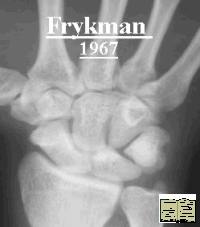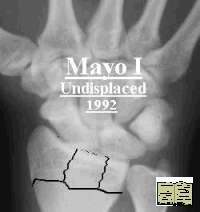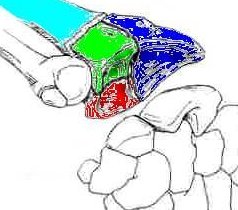Distal Radial Fractures
What can I accept?
Anatomical reduction/ position should be sought. (see overview)
Manipulation and reduction is warranted if:.
-
>2 mm loss of radial height
-
change in radial inclination of > 5°
-
loss of volar tilt of > 10°
-
loss of reduction of the distal radioulnar joint
-
>1 to 2 mm of intra-articular step
Surgical intervention is considered when an acceptable reduction cannot be achieved or maintained by closed means
Once reduced, ways to hold it are:
- Moulded cast
- K wires and moulded cast
- Internal fixation volar or dorsal plate
- External fixation
- Combinations of above.
Classification
Extra articular Vs Intra articular (see intra articular)
Use of eponyms are being discouraged. (but still commonly used)
|
Colles |
- Extra-articular with dorsal angulation, displacement and shortening |
|
Smiths |
- Extra articular fracture with palmar/ volar displacement |
|
Bartons |
- Intra articular fracture, usually described as volar or dorsal dpending on predominant direction of displacement |
Intra articular fractures
The existing classification systems are helpful for describing the fractures but not for assessing their stability or for deciding management. Fractures with >1 mm of displacement of the articular surface may benefit from operative treatment.
Operative options include limited open reduction and internal fixation, arthroscopically assisted internal fixation, and open reduction and internal fixation. The long-term functional outcome is determined in part by the severity of the fracture as defined by the amount of comminution, the initial severity of displacement, and the number of fracture fragments.
Of all of the extra-articular parameters, restoration of the length of the radius is the most important for enhancing recovery of motion and grip strength and for preventing problems involving the distal radioulnar joint.
Classification systems
- Frykman
- Mayo
- Melone
- Jupiter and Fernandez
- AO
Frykman Classification
 |
Frykman Classification (1967)(1-8 Even Numbers include ulna styloid) I - Extraarticualr fracture, II - + ulna styloid III - Involving Radio carpal jt, IV - + ulna styloid V - Involving DRUJ, VI - + ulna styloid VII - Radio carpal & DRUJ, VIII - + ulna styloid |
Focuses on the intra-articular extension of the fracture, involvement of the ulnar styloid and draws attention to the DRUJ. Because displaced and non-displaced fractures are considered equally important, this system cannot be used to predict outcome as accurately as other systems.
Mayo Classification
 |
Mayo Classification (1992)
I - Undisplaced II - Radioscaphoid III - Radiolunate (Die punch) IV - Radioscapholunate |

Distinguishes extension of the fracture into either the radioscaphoid or the radiolunate joint. The ulnar styloid process is ignored in the Mayo system.
Melone Classification
System is based on the belief that the condition of the medial portion of the articular column of the distal aspect of the radius is important for determining the prognosis and the options for treatment This system was one of the first to provide an accurate description of the way in which most fractures propagate through the articular surface of the radius.
Jupiter and Fernandez Classification
Modification of the AO system that takes into account the mechanism of injury, including bending, shear, compression, and avulsion (traction). It also includes complex fractures that result from a combination of at least two of these mechanisms of injury. Jupiter and Fernandez expanded the AO classification to include avulsion fractures caused by radiocarpal dislocation and high-velocity combined injuries. This is an excellent system that includes information on fracture displacement and the number of fracture fragments. On the basis of the main fracture type and the direction of displacement, the classification consists of approximately twenty-five subtypes. Because this is a newer system, scant data are available for comparing the ease and accuracy of its use with those of other classification systems.
AO Classification
The AO classification system, comprises twenty-seven categories, is the most detailed. It also is the most inclusive, making it useful for broad anatomical categorization of large numbers of fractures for trauma registries even though it is cumbersome and lacks sufficient focus for use in clinical decision-making. Andersen et al found significant (p < 0.05) agreement between reviewers when this system was reduced to three classifications: extra-articular, partial articular, and complex articular.
Extra articular
Partial Intra-Articular Fractures (AO Type B)
Shear injuries cause fractures of the volar and dorsal rims, fractures of the radial styloid process, and medial corner fractures, whereas impaction injuries cause die-punch fractures. These injuries may include additional, smaller fractures or non-displaced fractures that do not necessitate separate treatment, but the feature that is common to all is sparing of a portion of the articular surface that remains in continuity with the metaphysis; this adds greatly to the stability of the fracture.
Complex Articular Fractures
These injuries, which generally are higher-energy fractures than type-B fractures, often involve a combination of shear and impaction. None of the articular surface remains in continuity with the metaphysis. The fractures can be classified simply as those with a dorsal pattern, those with a volar pattern, or direct impaction fractures with or without comminution. Although the fracture pattern can involve the so-called T or Y-split of the articular surface in primarily the sagittal or coronal plane, most of these complex fractures involve a component of both.
THOMAS E. TRUMBLE, RANDALL CULP, DOUGLAS P. HANEL, WILLIAM B. GEISSLER, and RICHARD A. BERGER Instructional Course Lectures - Intra-Articular Fractures of the Distal Aspect of the Radius - JBJS - A 1998 80: 582-600
Paul M. Simic and Andrew J. Weiland - Fractures of the Distal Aspect of the Radius: Changes in Treatment Over the Past Two Decades - JBJS - Am 2003 85: 552-564
Frykman, G.: Fracture of the distal radius including sequelae—shoulder-hand-finger syndrome, disturbances in the distal radial-ulnar joint and impairment of nerve function. A clinical and experimental study. Acta Orthop. Scandinavica, Supplementum: 108, 1967.